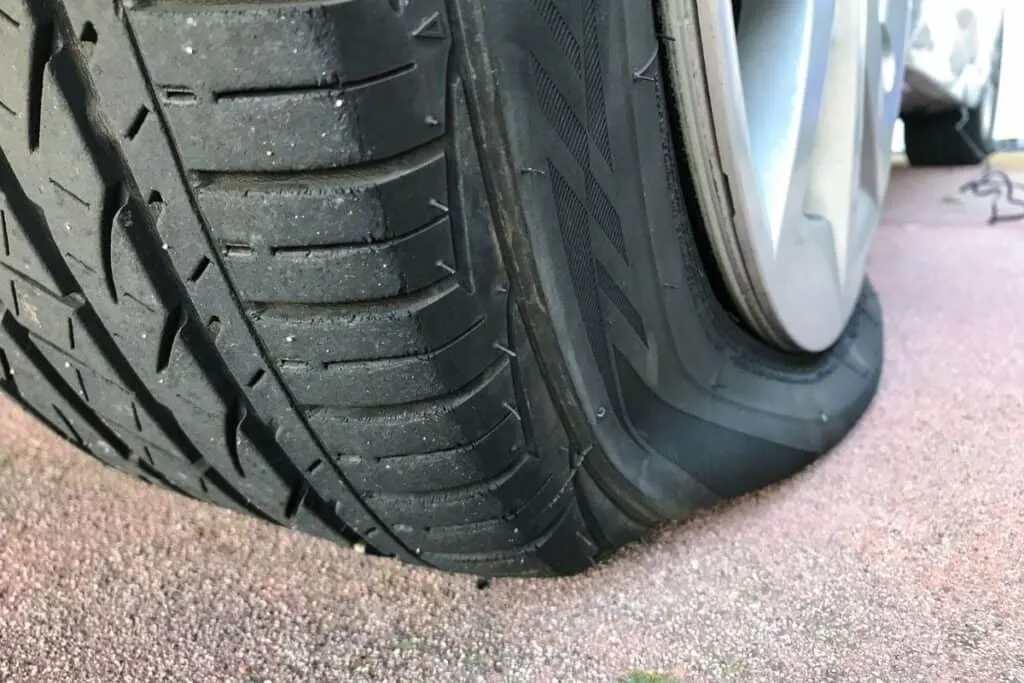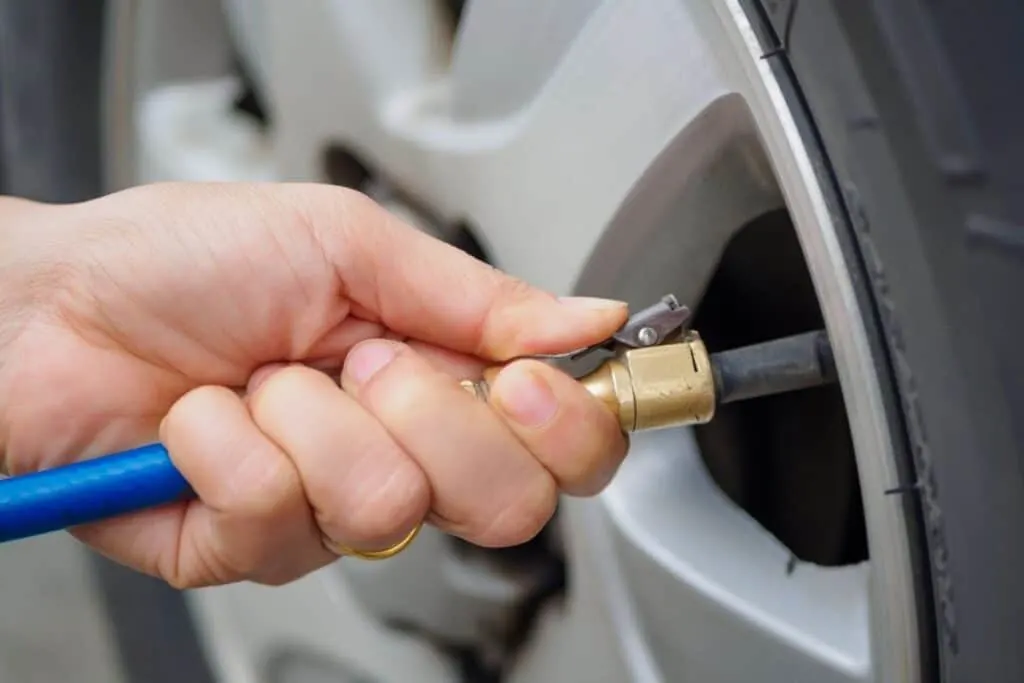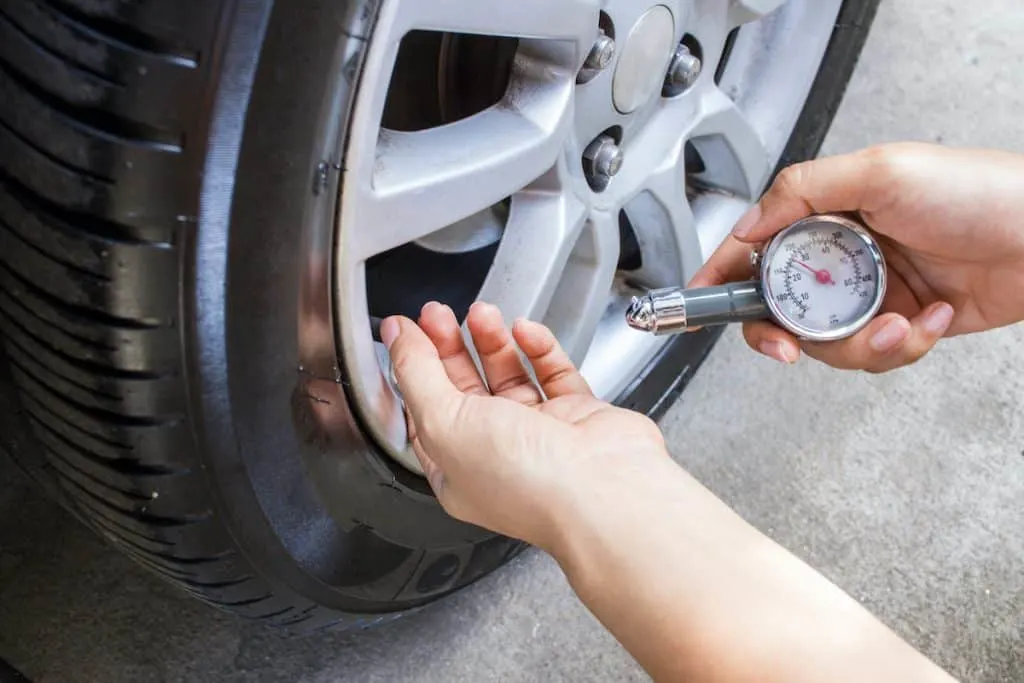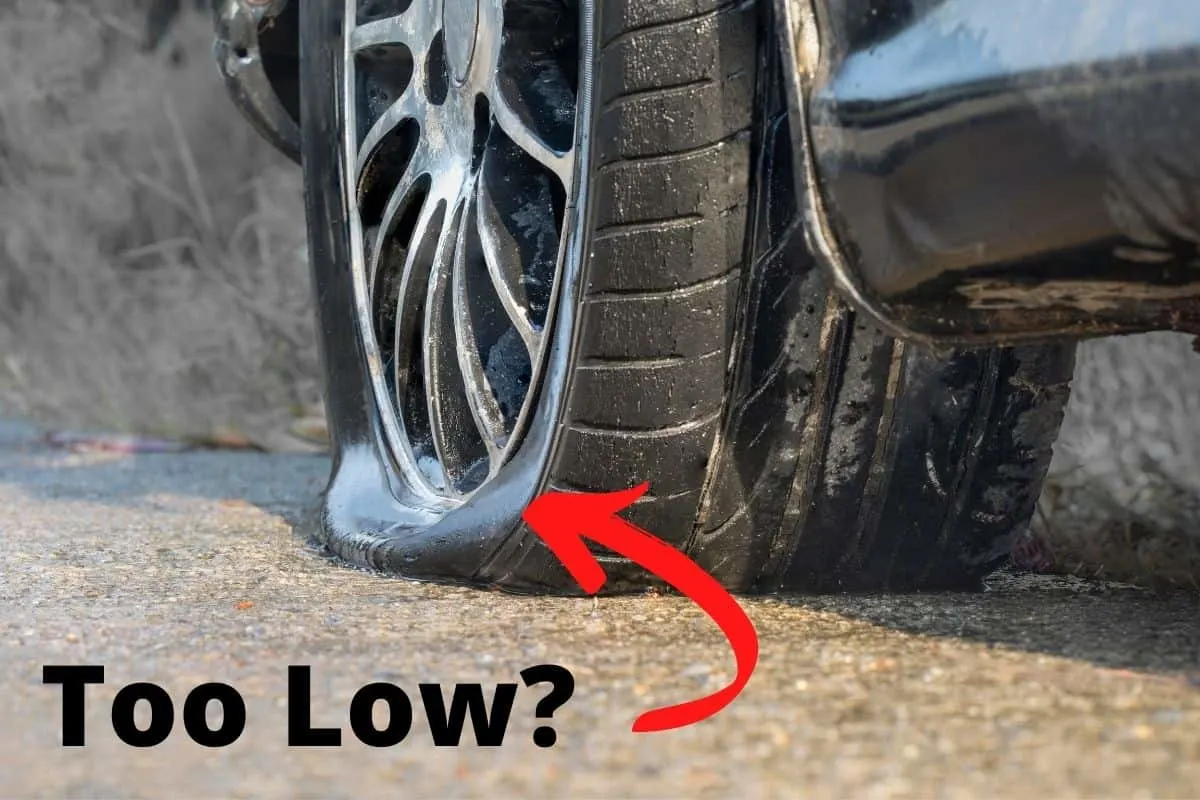If there is one part of your vehicle you shouldn’t ignore, it’s your tires. Along with ensuring they have plenty of tread and are in good condition, you don’t want to let the air pressure in your tires drop to levels that may make it very unsafe for you to drive!
A safe tire pressure range for most standard vehicles falls within the range of 30-35 pounds per square inch (PSI). However, you’ll want to check your specific vehicle manufacturer’s suggested tire pressure for safe driving.
Since there are many aspects involved as to when tire pressure is too low, how it got too low, and what can be done to solve the problem, here’s what you need to know so that you’re safe on the road.
What Happens When Tire Pressure is Too Low?
Unbeknownst to you, many things occur while you are driving on tires where the pressure is too low. For starters, much more of the tire’s surface actually comes into contact with the road at any given moment.
While this may not sound like a big deal, it is!
As more of your tire’s surface touches the road, this results in an increased buildup of friction. Should this continue, the result can be your tire overheating, since the chemicals involved in making your tire will start to break down, especially if you are driving at higher speeds.
When this occurs, the result could be a blowout and an accident that could leave you and others with serious injuries.
Hopefully, this won’t happen to you. But even if it doesn’t, driving around with low tire pressure will cheat you out of additional gas mileage, since your car has to work harder when tire pressure is very low.
Thus, while you may not be stopping at the gas station to add air to your tires, you will be spending lots of money unnecessarily to keep your gas tank filled up.

Can You Drive with Low Tire Pressure?
While you can still drive your car with low tire pressure, we recommend against it. But if you absolutely have to do it, there are certain tips you should keep in mind.
First, try to drive only very short distances. If you try to drive long distances at higher speeds with low tire pressure, you increase the risk of tire failure and a blowout.
Next, remove as much excess weight from your car as possible. Whether this means having few if any other people in the car with you or not loading it down with groceries or other items, decreasing your car’s weight will put less stress on the sidewalls of your tires.
Finally, try to drive as far below the specified speed limit as you can while still being safe. The more you exceed the speed limit, the more pressure this puts on your tires.
When this happens, your car can start to feel unstable on the road, making it likely you may have a blowout or other type of accident.
What is Considered Low Tire Pressure?
While there can be various opinions as to what is considered to be low tire pressure, we have found that on most standard passenger vehicles tires that have the pressure of 20 pounds per square inch are considered to have exceptionally low tire pressure.
Generally, tires on most standard vehicles require tire pressure of 32 pounds per square inch or higher, depending on the vehicle and the size of the tire. Should you try to drive your vehicle when the tire pressure is 20 psi or lower, you are essentially considered to be driving a vehicle that has a flat tire.
If you do so, you not only risk the potential for a blowout at high speeds, but also for damaging your vehicle’s suspension and other components, even if you are just driving around town at reduced speeds.
If you have a vehicle that contains a tire-pressure monitoring system, this will alert you with a light on your dashboard when any one or all of your tires have air pressure that is at least 25 percent below that recommended by the car’s manufacturer.
Thus, if you have a vehicle with tires that normally require 32 pounds of air per square inch, getting this alert means your tires have no more than 24 pounds of air pressure in them, which means a stop at the nearest gas station air pump is needed.
What is a Dangerously Low Tire Pressure?
Needless to say, the lower your tire pressure goes, the more danger you are putting yourself in when driving down the highway.
Once your tires have at least 25 percent less air pressure than is recommended by your vehicle’s manufacturer, we can say without any doubt this is a dangerously low tire pressure. Should you have one or more tires where the pressure is close to 20 pounds per square inch, you are then driving at your own risk.
If you notice a sudden drop in your tire pressure that results in a dangerously low pressure, pull off the road immediately and contact others for help. Since you will have no idea what may have happened, getting your tires looked at by professionals will be the smartest decision you can make.
While a 25 percent reduction is generally what most experts consider to be tire pressure that is dangerously low, some manufacturers now have guidelines stating that even a 10 percent reduction in your vehicle’s tire pressure may be considered dangerous.
In many cases, this can be a drop of only three to five pounds per square inch in your tire. Rather than run the risk of a serious or even fatal accident, take heed of the warning light from your tire-pressure monitoring system and check your tires as soon as possible.

Safe Tire Pressure Range
When you’re trying to figure out what is the safe tire pressure range, you may get a bit confused, since it can vary from one manufacturer to another. However, we have found that most experts agree a safe tire pressure range for standard vehicles falls within the range of 30-35 pounds per square inch.
To know your vehicle manufacturer’s suggested tire pressure, look for a label inside your car.
Usually, this is found on your vehicle’s door, the doorpost, or inside the glove compartment. On the label, you’ll see recommendations for your vehicle’s front and rear tires, as well as your spare tire.
Also, remember that when you replace your tires, these same guidelines will still apply, assuming you bought the same type of tires. However, if you go up in size and put larger tires on your car, it’s best to check the sidewalls of your new tires to find the maximum cold PSI level.
If you want to check the pressure in your tires, it’s best to do so first thing in the morning or at least three hours after you have finished driving.
Should you try to check your tire pressure immediately after you pull into your driveway, you may get an inaccurate reading on your tire gauge due to your tires not having enough time to cool down.
Why Tires Lose Pressure
When the tires on your car lose air pressure, we are here to say it could be for one of several different reasons.
First, you might have a missing valve stem cap. If you don’t have this cap on the valve stem, debris and dirt can enter the valve stem, eventually penetrating its seal. When this happens, air will begin to leak out very slowly.
In some cases, a degraded valve stem is to blame for the loss of tire pressure. Usually made of plastic, valve stems can become damaged or work themselves loose when you are driving, leading to a loss of tire pressure.
Should you notice a sudden drop in your tire pressure, it’s likely your tire has been punctured. Though today’s tires are made much better and are able to withstand running over many types of objects, they are not completely bulletproof in these situations.
Thus, if you run over a nail, broken glass, or some very sharp rocks, your tire may get punctured.
Believe it or not, Mother Nature can rob your tires of their air pressure, especially when the weather turns cold. In fact, when the temperature drops only 10 degrees, you can often expect to lose as much as two pounds of air pressure in your tires.
Therefore, on those cold winter mornings, we suggest you always check your tire pressure before heading off to work or other destinations, especially if you are experiencing a severe cold snap.
Finally, if your car’s tires are misaligned with the wheel, a loss of air pressure can result. When a misalignment occurs, air pressure will leak through the sides. If you suspect this is the problem, take your car to a mechanic right away.

Ways to Tell that Your Tire Pressure is Too Low
Along with the obvious method of using a tire gauge to check your tire pressure, we know a few other ways you can tell that your tire pressure is too low.
First, check to see if your tires feel soft and squishy. While soft and squishy may be good for some things, it’s not a good thing for your tires. If you put your hand on your tire and are able to press down a bit too much, you’ve got low tire pressure.
Fortunately, a few pumps of air should solve the problem!
Next, we have what is referred to as the “eyeball test.”
This will take a bit of time and practice but can come in very handy for those times when a tire gauge may be nowhere to be found.
Once your vehicle is parked on a flat surface, take a close look at the tires from the front and rear of your vehicle. Should you notice any part of your tires protruding, chances are they don’t have enough air in them and need to be pumped up a bit.
Now that you know much more about tire pressure, don’t be like so many others and ignore your tires!
By keeping them properly inflated, you’ll get maximum gas mileage from your vehicle and have it be much safer as you drive down the highway.
Frequently Asked Questions (FAQs)
Is 28 Too Low for Tire Pressure?
The simple answer to this question is yes. If your tires require 32 or more psi and they have dropped to 28, that’s a reduction of more than 12 percent. While you probably won’t notice much difference in how your car handles or brakes, it’s best to get them filled back up to recommended levels as soon as possible.
Is 35 Tire Pressure Too Low?
While 28 psi is usually too low, having tire pressure of 35 psi is not. Actually, it is often considered to be a bit high for most standard passenger vehicles, although most manufacturers recommend 32-35 psi per tire. Yet when faced with tire pressure that is too high or too low, we say being a bit high will keep you safer on the road. In most cases, having slightly more air pressure in your tires than you need won’t impact how your tires wear or how your car handles.
Is 40 PSI Too Low?
When you have 40 pounds of air pressure in your tires, this is not too low, but in fact, is too much of a good thing. At 40 psi, less of your tire touches the road, making you feel as if you are bouncing while driving. Also, it will lead to your tires wearing out prematurely and can cause them to overheat, meaning you could suffer a blowout or other accident.
Is 37 Tire Pressure Too High?
In our experiences, having a tire pressure of 37 is usually not considered high enough to pose any significant problems with most vehicles. As we stated earlier, having a bit too much pressure in your tires is better than having them be too low. Under normal driving conditions, tire pressure increases about five pounds per square inch. In case you’re worried, a tire has to reach about 200 psi before it will explode.
